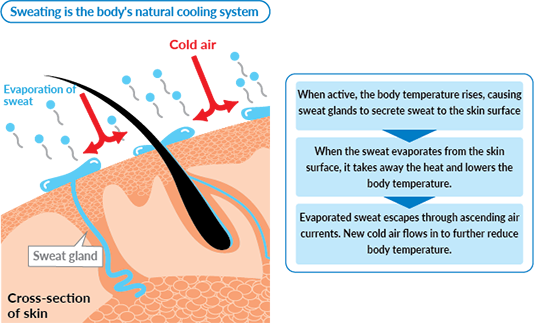Cooling Fabrics
How do Cooling Fabrics Work?

What is Evaporative Cooling?
Cooling fabrics are becoming more popular than ever in ready-to-wear fashion. The question is, how? Cooling Fabric is designed to both enhance the body’s evaporative cooling mechanism (sweating) and to act as a wearable “swamp cooler”. Sounds good, doesn’t it?
Our bodies sweat to release excess heat. When we are hot enough that we have sweat beading on our skin, the sweat (water) molecules that are closest to the surface with the highest kinetic energy are able to break their hydrogen bonds and become water vapour. Breaking the bond releases heat so the vapour molecule is cooler than the liquid molecule. For a more detailed explanation, check out this great explanatory video by Khan Academy:

What is a Swamp Cooler?
The ”swamp cooler” concept is that warmer and dryer air that passes over something cooler and damper, will become cooler. Ancient Egyptians used damp reed matts or clay pots filled with water in locations where the hot dry breezes would blow over them, resulting in cooler breezes on the other side. The cooler water uses the energy from the warmer air to help it turn from a liquid to a vapor (evaporation). As we know, the process of evaporation releases heat and therefore the air is now cooler than the air that has not passed over the swamp cooler.
Evaporative Cooling and Cooling Fabrics
Some of our Cooling Fabrics
A cooling fabric works when it is damp, either through perspiration or intentionally wetting prior to use. Once wet, it retains moisture (these fabrics are not fast drying) so that the ambient air passing over the damp fabric becomes cooler as the water molecules evaporate. The greatest temperature difference occurs when the ambient air is warm and dry. While there is still some cooling effect in warm and humid environments, it is less than in dryer climates.
Polartec® Delta™ and Coolfab Jersey are ideal fabrics for making summer tops for both activewear and leisure. You can either dampen your garment prior to wearing it or simply get hot and sweaty and then notice how the air above your shirt will not feel as hot as the air all around you. It should be noted that when making tops from Delta and Coolfab, they should have a relaxed fit so that air can move freely over and under them for maximum evaporative effect. In the paddle board photo below, Polartec Delta style 6087OR was used to make this sun shirt. In 28 degrees Celcius, Martha did not overheat despite paddling in the sun all day for four days!
Cooling Microfiber is a specialty cooling fabric used to make cooling towels. When worn around one’s neck, the cooling effect is very noticeable and welcome on a hot summer’s day! This fabric stays moist longer than other fabrics, and can be used for long periods of time before having to re-wet. In this video, Leslie demonstrates how the cooling microfiber can be wetted with warm water and in a matter of minutes, it cools down substantially to provide cooling relief!
Martha wearing Polartec Delta cooling fabric

HyperKewl™ is an absorbent layer that works much the same way as Cooling Microfiber and is intended to be sandwiched between a breathable outer fabric and waterproof fabric lining. This allows the wearer to stay dryer.
This highly technical cooling fabric is used to make cooling vests and other cooling garments for sport, military, construction, pet and equine industries. In fact, several country's Olympic athletes used garments with HyperKewl™ in Tokyo 2021. The brand, Techniche makes several cooling garments with HyperKewl™ Plus (pre-quilted HyperKewl™ fabric).
Some of our Cooling Fabrics
Cooling Fabric - The Conclusion
Cooling fabrics have emerged as revolutionary materials designed to enhance comfort and performance in everything from athletic wear to everyday clothing. By efficiently wicking away sweat and moisture from the skin's surface yet retaining some in the outer layer, these fabrics help maintain comfort and preventing potential skin irritations.
Key Features and Benefits of Cooling Fabric
- Cooling fabrics often feature enhanced breathability, allowing air to circulate more freely to promote ventilation, which further contributes to temperature regulation and comfort.
- Fabrics are usually light weight with stretch, which offers unrestricted movement and flexibility, crucial for athletic activities.
- The durability and longevity of cooling fabrics make them a sustainable choice, as they require less frequent replacement compared to traditional textiles, thereby reducing waste and contributing to a more environmentally friendly approach to apparel production.
-
The versatility of cooling fabrics extends beyond activewear, with applications in various industries such as healthcare, where they can provide relief to patients experiencing hot flashes or discomfort due to medical conditions.
Overall, the benefits of cooling fabrics encompass improved thermal comfort, enhanced performance, breathability and versatility, making them an indispensable when working or playing in hot climates.